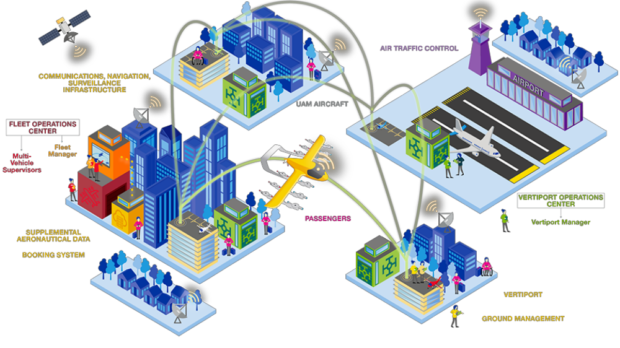and its joint venture, Wisk, have partnered to release a Concept of Operations (ConOps) for uncrewed passenger-carrying urban air mobility (UAM) operations using highly-automated, electric aircraft. This release includes a summary and detailed ConOps documents.
While the ConOps is presented within the context of the United States National Airspace System (NAS), it is intended to provide a blueprint for global UAM operations. The ConOps is for the safe initiation of uncrewed UAM passenger operations in the NAS by the end of this decade, while providing a stepping stone to the goal of transitioning to high-throughput operations in the years to follow.
This ConOps outlines the key principles and assumptions for UAM aircraft, the operational environment, and normal operations. The Boeing and Wisk ConOps extends existing airspace concepts and covers uncrewed UAM aircraft, fleet operations centers, third-party service providers, vertiports and vertiport managers, and airspace infrastructure. Ultimately, public acceptance of uncrewed UAM operations will be the crucial component to scaling the market.
“We’re working to enable a future of aerospace that is safe, sustainable and at scale. Uncrewed operations will be fundamental to realizing that vision, and we have to exceed the current safety standards for the air transportation system,”
said Brian Yutko, Boeing Vice President and Chief Engineer of Sustainability & Future Mobility.
The concept of operations begins by proposing bedrock principles for urban air mobility, including that flights should be safe and affordable for everyone. Additionally, the aircraft would be automated to reduce the load on air traffic controllers and pilots, and they would fly day or night under visual or instrument flight rules, and be supported by automated onboard and ground-based systems.
“The important work we’re sharing today provides a stepping stone in the advancement of UAM in the U.S. and the world,”
said Gary Gysin, CEO of Wisk, which has been working to bring to market the first all-electric, self-flying air taxi in the U.S.
“The vision we have outlined is the result of many years of collaboration with Boeing, the FAA, NASA and key industry stakeholders. As a result, this document offers the most comprehensive framework proposed to date with a vision for enabling UAM in the national airspace. Wisk is committed to deliver, with its partners, on this vision,” said Gysin.
Boeing and Wisk say that evolutionary and pragmatic methods will be needed to make the vision of UAM a reality. This includes the creation of new infrastructure such as ‘vertiports,’ locations where UAM aircraft can take off and land, load and unload passengers, and receive services. Additionally, while the aircraft will be automated, Boeing and Wisk recommend the creation of ‘fleet operations centers’ where ‘multi-vehicle supervisors’ will monitor flights, implement air traffic control instructions to maintain aircraft separation, and ensure safe operation of the flight.
“The work we’ve done with our partners at Wisk demonstrates how this shared vision can become reality, and we’re excited to share these ConOps with public, government, policy and regulatory stakeholders to engage across industry to shape that future,” said Yutko.
As we build together, the industry will change shape and evolve. We invite your inputs and feedback to this ConOps for uncrewed UAM.
For 11-Page Summary Document click here.
For 64-Page Detailed Document click here.
Source: Press Release

